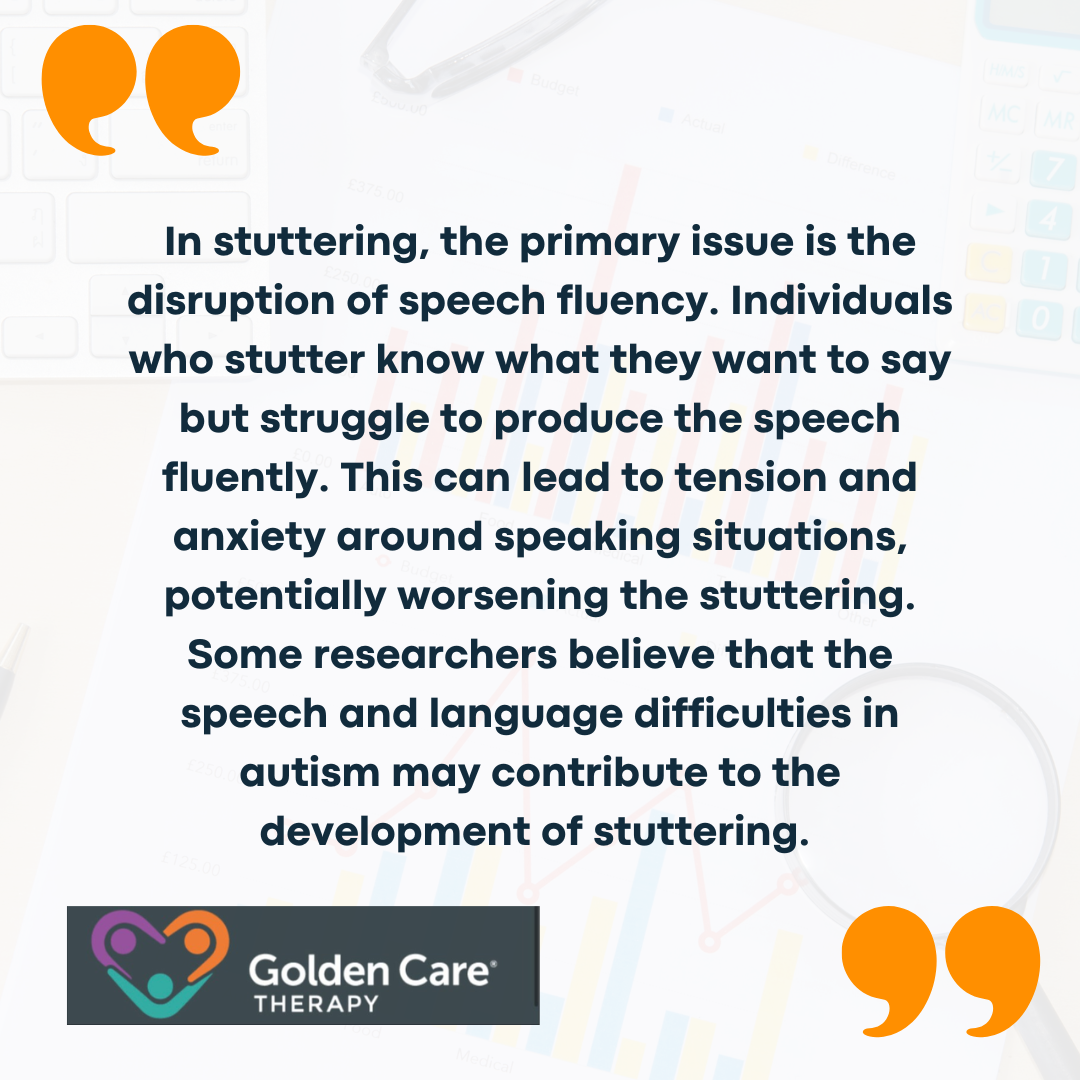Autism and stuttering are two distinct conditions that both affect communication. Understanding whether there is a connection between these conditions is crucial for developing effective strategies for diagnosis, intervention, and support.
That said, is there really a potential link between these two? Let’s find out.

Understanding Autism Spectrum Disorder (ASD)
Autism spectrum disorder is a developmental disorder characterized by challenges with communication, behavior, and social interaction. The term “spectrum” reflects the wide range of symptoms and their varying degrees of severity.
Individuals with autism may experience difficulties with social interactions, be it verbal or non-verbal communication, and may engage in repetitive behaviors and have restricted interests. Sensory sensitivities are also common among individuals with autism.
That said, the causes of autism are not fully understood, but research suggests a combination of genetic and environmental factors. Early diagnosis and intervention are crucial as they can significantly improve outcomes for individuals with ASD. Interventions often focus on developing communication skills, improving social interactions, and managing behaviors.
Understanding Stuttering
On the other hand, stuttering, also known as stammering, is a speech disorder marked by disruptions in the flow of speech. These disruptions can manifest as repetitions of sounds, syllables, or words; prolongations of sounds; or blocks where no sound is produced. Stuttering can vary in severity and may be influenced by factors such as stress, excitement, or pressure to speak.
Stuttering typically begins in childhood and can persist into adulthood. The exact cause of stuttering is not known, but it is thought to involve a combination of genetic, neurological, and environmental factors. Some individuals who stutter may experience secondary behaviors such as eye blinks, facial grimaces, or other movements that accompany their stuttering.

Exploring the Link Between Autism and Stuttering
The relationship between autism and stuttering is complex and multifaceted. While both conditions affect communication, they do so in different ways. However, there are several areas where overlap or co-occurrence has been observed.
Research on the prevalence of stuttering among individuals with autism has yielded varying results. Some studies suggest that stuttering may be more common in individuals with autism than in the general population, even among those with high-functioning autism.
For instance, a study published in the “Journal of Fluency Disorders” found that approximately 4-5% of children with autism also exhibited stuttering, compared to about 1% of children in the general population. This higher prevalence indicates a possible link between the two conditions.
Another study reported that children with autism who have average or above-average intelligence are more likely to experience stuttering. This finding suggests that certain subgroups within the autism spectrum may be more prone to developing stuttering.
Understanding these patterns can help in identifying and supporting individuals who may be at higher risk.
Speech and Language Development
Both autism and stuttering involve challenges with speech and language development, but these challenges manifest differently. In autism, speech and language difficulties can include delayed language acquisition, echolalia (repeating words or phrases), and difficulty understanding and using language in social contexts.
These communication challenges can impact an individual’s ability to interact socially and can lead to frustration and social withdrawal.

For instance, children with autism who struggle with expressive language may experience increased tension and anxiety when speaking, potentially leading to stuttering behaviors. This interplay between language difficulties and emotional factors highlights the need for comprehensive speech and language assessments in children with autism.
Neurological and Genetic Factors
There is evidence to suggest that both autism and stuttering have neurological and genetic components.
Studies using brain imaging techniques have shown differences in the brain structures and functions of individuals with autism and those who stutter. For example, abnormalities in the brain regions responsible for speech production and processing have been observed in both groups. These neurological differences may contribute to the speech and communication challenges seen in both conditions.
Genetic studies have also identified potential links between the two conditions. Certain genes associated with speech and language development have been implicated in both autism and stuttering. However, the specific genetic pathways and mechanisms involved are still being studied.

Anxiety and Social Factors
Anxiety is a common comorbidity in both autism and stuttering. Social anxiety, in particular, can exacerbate communication difficulties in individuals with either condition. For individuals with autism, social interactions can be challenging due to difficulties with social cues and non-verbal communication. This can lead to social anxiety and avoidance of social situations.
For those who stutter, fear of negative evaluation and social embarrassment can worsen stuttering behaviors. The anticipation of stuttering can create a cycle of anxiety and increased stuttering, making social interactions even more challenging.
The link between anxiety and communication challenges may contribute to the co-occurrence of autism and stuttering. For example, a child with autism who is anxious about social interactions may develop stuttering as a response to this anxiety. Conversely, a child who stutters may experience increased social anxiety, further complicating their communication difficulties.
Case Studies and Personal Accounts
Personal accounts and case studies provide valuable insights into the experiences of individuals with both autism and stuttering. These narratives highlight the unique challenges and strengths of individuals with co-occurring conditions.
For example, a case study published in the “Journal of Fluency Disorders” described a young boy with autism who developed stuttering at the age of five. Despite significant speech and language delays, the child showed improvement in fluency with the help of speech therapy tailored to his needs.
This case underscores the importance of individualized interventions that address both autism and stuttering. Speech therapists can design customized therapy plans that focus on the specific speech and language challenges faced by each child.
Implications for Intervention and Support
Understanding the potential link between autism and stuttering has important implications for intervention and support. Effective strategies should consider the unique needs and strengths of individuals with co-occurring conditions.
Early Diagnosis and Intervention
Early diagnosis and intervention are crucial for both autism and stuttering. Parents and caregivers should be vigilant for signs of communication difficulties and seek a professional evaluation if concerns arise. Early intervention can help address speech and language delays, reduce anxiety, and improve overall communication skills. Pediatricians, speech-language pathologists, and other professionals play a key role in identifying and supporting children with these conditions.
Speech Therapy
Speech therapy is a cornerstone of intervention for both autism and stuttering. Speech-language pathologists (SLPs) can develop personalized therapy plans that address the specific challenges faced by individuals with co-occurring conditions.
Techniques such as fluency shaping, stuttering modification, and social communication training can be effective. Therapy may also incorporate strategies to manage anxiety and build confidence in communication.
Multidisciplinary Approach
A multidisciplinary approach is often beneficial for individuals with autism and stuttering. Collaboration between speech-language pathologists, psychologists, occupational therapists, and educators can ensure comprehensive support. This approach can address not only speech and language difficulties but also social, emotional, and behavioral needs. Regular communication and coordination among professionals can enhance the effectiveness of interventions.
While autism and stuttering are distinct conditions, there is evidence to suggest a potential link between the two. The co-occurrence of these conditions can present unique challenges, but with early diagnosis, personalized intervention, and comprehensive support, individuals with autism and stuttering can achieve significant improvements in communication and overall quality of life.
Ongoing research is essential to deepen our understanding of the connections between autism and stuttering and to develop more effective interventions for those affected.
Sources:
https://www.1specialplace.com/2023/06/16/autism-and-stuttering-asd-case-study
https://stamma.org/about-stammering/stammering-autism
https://www.fortespeech.com/whats-the-link-between-stuttering-and-autism



